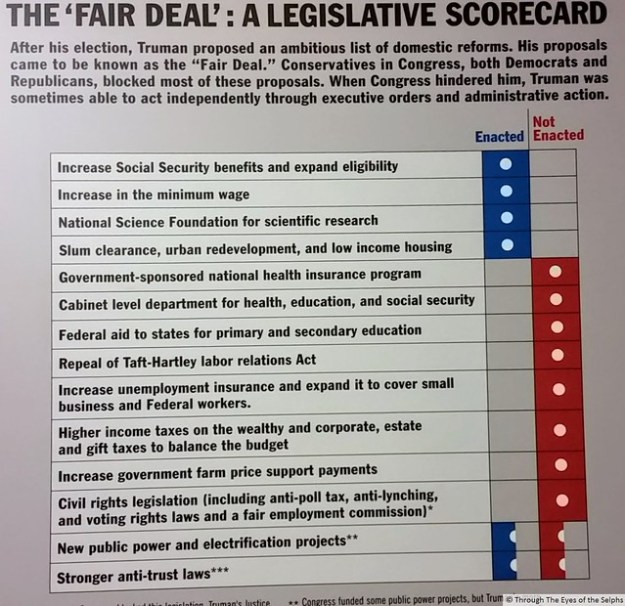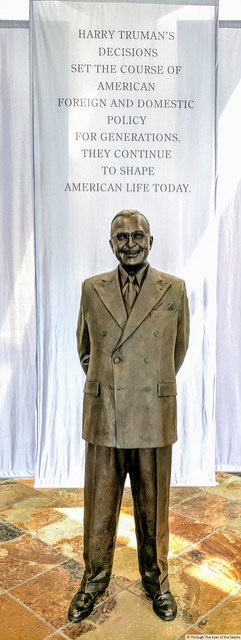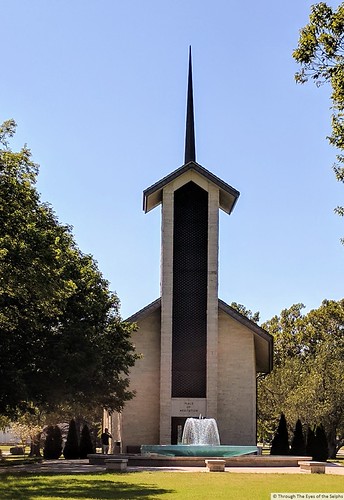Sunday we left Papillion Nebraska and headed towards Independence, Missouri. It was a longer travel day than usual for us, but the miles passed quickly. We passed over the Missouri River and as we passed through Kansas City we caught a glimpse of Kauffman Stadium where the 2015 World Series Champion Kansas City Royals were playing a home game.

We arrived at our campsite at Blue Springs Lake Campground just outside Independence.
 Our main reason for coming to northwestern Missouri was to tour the Truman Presidential Library and Museum in Independence, population 117,000. This was the first presidential library to be created under the provisions of the 1955 Presidential Libraries Act. The Presidential Library and Museum was dedicated on July 6, 1957 and Truman actively participated in the day to day operations of the library. In the lobby is a beautiful mural entitled “Independence and the Opening of the West”. We began our visit with a video detailing Truman’s life from birth to the beginning of his presidency in 1945.
Our main reason for coming to northwestern Missouri was to tour the Truman Presidential Library and Museum in Independence, population 117,000. This was the first presidential library to be created under the provisions of the 1955 Presidential Libraries Act. The Presidential Library and Museum was dedicated on July 6, 1957 and Truman actively participated in the day to day operations of the library. In the lobby is a beautiful mural entitled “Independence and the Opening of the West”. We began our visit with a video detailing Truman’s life from birth to the beginning of his presidency in 1945.
Harry Truman, our 33rd President, (1945-1953) was a very simple, common man. In no way do I mean that in a negative way. He was a man with humble beginnings on a farm in Missouri. He did not attend college because his family could not afford it. He worked in Clinton’s Drug Store at the age of 14, before and after school and all day on weekends, making $3.00 a week. He was never comfortable with the pomp and circumstance of life in the White House and never warmed to being served his meals by butlers and servants. After his presidency ended he spent time at his presidential library personally training docents, talking with school groups, answering phones giving directions and answering questions.
Truman was convinced the White House was haunted. He didn’t realize it was the White House about to fall down around him! 

We found Truman’s reflections on life in the White House and his thoughts on previous Presidents in letters to his wife and daughter fascinating. I know these are not easy to read because they didn’t photo well, but I hope you can make them out.



Truman’s political career began as a county administrator. He once said his years in the Senate were the ten happiest years of his life. In the Senate he found a brotherhood unlike any other he had ever experienced.
Truman was chosen as Roosevelt’s running mate as a “Missouri Compromise”. Democratic party leaders knew Roosevelt would most likely not survive another term. They distrusted the current Vice President, Henry Wallace, and Truman was seen as a moderate border state Senator, acceptable to both liberal and conservative Democrats. At first Truman did not want the job of Vice President. During the Democratic National Convention, Roosevelt told Truman if he refused the nomination he would be responsible for breaking up the Democratic Party in the middle of the war. Truman felt the call to duty and accepted.
On April 12, 1945 Truman was summoned to the White House where Eleanor Roosevelt told him the President was dead. He had only been Vice-President for 82 days. When he asked Mrs. Roosevelt if there was anything he could do for her, her response was, “Is there anything we can do for you? For you are the one in trouble now”.
He was sworn in as the 33rd President later that evening. The next morning Truman asked reporters to pray for him and said “it felt like the moon, the stars, and all the planets had fallen on me”.
Truman took over as President with a country at war. Few presidential acts have been met with as much controversy as his decision to use atomic weapons against Japan. Even though seventy years has passed, the debate continues.

After the war ended Truman had his hands full with the challenges of shortages, inflation and labor unrest. The worst shortage was in housing as soldiers came home, married and started families. During the war little permanent housing had been built because building materials were needed for defense production. Truman tried to remedy the situation with public housing and federally subsidized homes but his plans were derailed by Congress who felt the marketplace would fix itself. The shortage persisted.
Here is his Oval Office with TV and back then the reporters were briefed in the Oval Office.

During the war, wage and price controls had kept inflation under control but once the war ended, restrictions eased and unions began striking for higher pay. By February 1946, over two million workers had gone on strike, many in key industries like steel, mining, railroads and automobiles. Truman ordered government takeover of the mines, railroads and threatened to draft railroad workers into the army. These steps damaged his relationships with labor unions.
After price and wage controls were lifted after the war, there was a massive rise in inflation. During the second half of 1946, consumer prices rose at an annual rate of 30% and wholesale prices rose 50%, especially in food like meat. The double digit inflation continued into 1947 and Truman’s popularity plummeted with some wondering if he was up to the job of President.
But as the economy adjusted to peacetime, production continued to increase which generated large investments in manufacturing along with government spending for military and domestic projects. The United States was now the world’s economic powerhouse with 7% of the earth’s population which produced half of the world’s manufacturing output. Per capita income was 50% higher than any other country and unemployment barely averaged 4%. Americans were now consuming and earning more than ever and the GI Bill provided healthcare, Education Grant’s, as well as home and business loans for veterans.
In 1948, the state of Israel was announced and Truman immediately recognized the new nation, the first country to do so and against the advice of Secretary of State George C. Marshall. Marshall and others felt the new nation had little chance of survival and it would anger oil producing Arab countries. Truman felt deeply about the horrors of the Holocaust and the plight of displaced European Jews, but he also knew it would provide Jewish support in the upcoming 1948 presidential election.
He ran for President in 1948, crisscrossing the country in the Ferdinand Magellan, the Presidential railroad car (we have pictures of the car in our Miami blog).  He was the first president to fly on a regular basis. With economic difficulties and low popularity, some questioned his electability. He lost the support of Southern Democrats with his support of civil rights while others in the party attacked his policy on the Soviet Union. The Republican Congress had rejected almost all his domestic reform policies. Many felt he would not even win the Democratic nomination. The Democratic Party was split.
He was the first president to fly on a regular basis. With economic difficulties and low popularity, some questioned his electability. He lost the support of Southern Democrats with his support of civil rights while others in the party attacked his policy on the Soviet Union. The Republican Congress had rejected almost all his domestic reform policies. Many felt he would not even win the Democratic nomination. The Democratic Party was split.
Who can forget the famous incorrect newspaper headline the day after Election Day?

The Presidential Museum had interesting exhibits on the beginning of the Cold War which dominated his second term, overshadowing his domestic agenda of national health insurance, housing, civil rights and federal education. Little of what he called the “Fair Deal” was made law.
Truman’s foreign plan was to abandon isolationism and contain the Soviet Union through economic and military action. This led to the Truman Doctrine in 1947 and in 1948 the Marshall Plan.

From 1793 to 1949, America made no military treaties with European nations but Truman changed that with the formation of the North Atlantic Treaty Organization (NATO). America joined Canada and ten European nations in a treaty of mutual defense to defend Europe from Soviet attack with the agreement that an attack on one is an attack on all.
In June, 1950 North Korea invaded South Korea and Truman sent troops to South Korea. By 1951 some wanted Truman to bomb China and end the war. Truman feared this would lead to worldwide nuclear war. General Douglas MacArthur favored the bombing saying “there is no substitute for victory”. Truman, favoring a “limited war” and fired MacArthur citing the constitutional precedent that civilians, not generals, control the nation’s military policy. The firing was the most unpopular decision he ever made. His failure to end the war quickly led to further unpopularity at home.
On display was a Purple Heart and the letter from the father of a serviceman killed in Korea. The letter said since Truman was responsible for his son’s death, he might as well have his Purple Heart too. As the war dragged on his popularity continued to plummet and by the time he left office his popularity was below 30%.
 Truman expanded presidential power by reorganizing the executive branch and creating new agencies responsible to the President, including the Department of Defense, Atomic Energy Commission, Council of Economic Advisers and the National Security Council. He set a precedent for future presidents actions when he waged war in Korea without congressional declaration.
Truman expanded presidential power by reorganizing the executive branch and creating new agencies responsible to the President, including the Department of Defense, Atomic Energy Commission, Council of Economic Advisers and the National Security Council. He set a precedent for future presidents actions when he waged war in Korea without congressional declaration.
President Truman integrated the armed services and federal civil service and worked to end discrimination in voting, education, jobs and housing. Even though Congress blocked most of his proposals, they led the way for future civil rights leaders.
He did not seek a third term in office, saying he had had enough of Washington and preferred his life back home in Missouri. He had compared the White House to a big white prison on occasion.
Also on the grounds of the library are the gravesites of Harry and Bess as well as their daughter Margaret and her husband.

There is also Truman’s office he used daily after his Presidency from 1957 to 1966.

NOV 18, 1961 President JF kennedy, Vice President LB Johnson, President Eisenhower & President HS Truman at Sam Rayburn’s funeral
 We stayed over three hours at the Presidential Library and Museum. The Museum was well done and informative. We learned though Truman was a simple man, he served as President during a very complex time in American history.
We stayed over three hours at the Presidential Library and Museum. The Museum was well done and informative. We learned though Truman was a simple man, he served as President during a very complex time in American history.
After touring the library we made the short drive to the Truman home where they lived from the time of their marriage in 1919 until his death in 1972. Truman loved to walk and the city of Independence uses his silhouette.


Bess Truman continued to live there until she passed away in 1982 at the age of 97. Their daughter Margaret was born in the house in 1924. The house originally belonged to Bess Truman’s maternal grandfather and is where Bess and her family moved to in 1909. When Harry and Bess married they lived there with her mother. It served as the Summer White House during his Presidency. His Winter White House was in Key West, Florida (we have pictures of it in our Key West blog). Upon her death Bess Truman left the home in Independence to the United States to preserve the legacy of her husband and his presidency.
Truman Trivia:
- Truman was born on May 8, 1884 in Lamar, Missouri. The “S” in his name is only an initial to honor his grandfathers.
- The family moved to Independence when he was six and he always considered Independence his home town.
- As a child he dreamed of being a concert pianist and loved reading, especially history. By the time he was 14 years old he has read all the books in the Independence Public Library.

- Truman’s jobs included a bank clerk in Kansas City in 1903 as well as working on the family farm from 1906 to 1917. He wanted to attend college but after his father lost the family savings in risky investments he went to work as a bank clerk. He gave up that job to work on the 600 acre family farm because his family needed him. He worked twelve hour days planting crops and tending the farm animals.
- When his father died in 1914 he assumed responsibility of the farm. He left the farm in 1917 to enlist in World War I. He said his time on the farm taught him the value of hard work and common sense.


The only known picture without his glasses
- Harry married Bess Wallace on June 28, 1919 after he returned from World War I. They both loved to write love letters to each other, especially on their anniversary. There are more than 1300 handwritten letters from Harry to Bess in at the Presidential Library and Museum with a few on display.

- He and a friend opened a haberdashery store in Kansas City in 1919 after he returned from World War I but it went bankrupt. While he struggled to make a living with other jobs, he found success in the military. He started with the rank of Private in the National Guard of Missouri and left military service 37 years later as a Colonel in the U.S. Army Officers’ Reserve Corp.
- As Vice President Truman was the “forgotten man of the Roosevelt Administration. After the inauguration he only met with President Roosevelt twice. He presided over the Senate and once said, “I am trying to make a job out of the vice presidency and it’s quite a chore”.

- Truman and his family lived in Blair House for four years while the White House was being renovated. It is amazing to see how they gutted and rebuilt the White House from the inside.




Bulldozer inside the White House

- An assassination attempt was made on his life in 1950 while living at Blair House.
- “Our Goal Must Be – Not Peace In Our Time – But Peace For All Time”. Harry Truman at Independence Day address delivered at Monticello, Virginia July 4, 1947.
- “There can be no greater service to mankind, and no nobler mission, than devotion to world Peace.” Harry S. Truman




































































































































































































































































